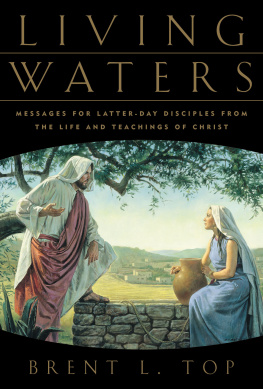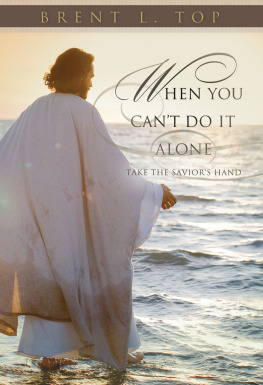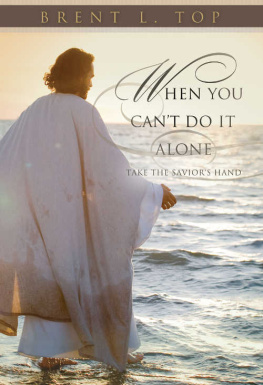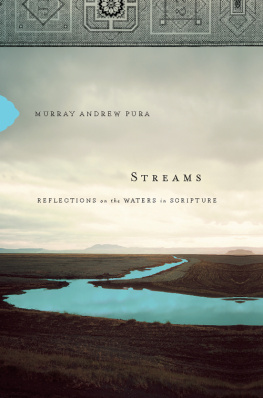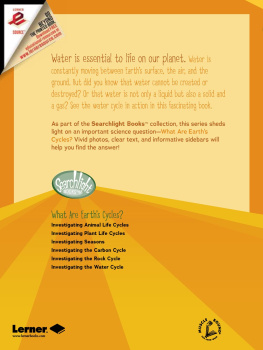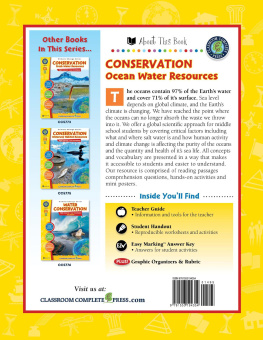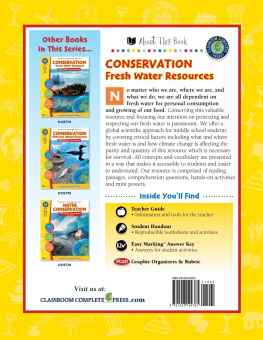Living Waters
Messages for Latter-Day Disciples from the Life and Teachings of Christ
Brent Top
2002 Brent L. Top.
All rights reserved. No part of this book may be reproduced in any form or by any means without permission in writing from the publisher, Deseret Book Company (permissions@deseretbook.com), P.O. Box 30178, Salt Lake City Utah 84130. This work is not an official publication of The Church of Jesus Christ of Latter-day Saints. The views expressed herein are the responsibility of the author and do not necessarily represent the position of the Church or of Deseret Book. Deseret Book is a registered trademark of Deseret Book Company.
Library of Congress Cataloging-in-Publication Data
Top, Brent L. Living waters : messages for Latter-day disciples from the life and teachings of Christ / Brent L. Top p. cm. Includes bibliographical references and index. ISBN 1-57008-830-6 (alk. paper) 1. Christian lifeMormon authors. I. Title.
BX8656 .T66 2002 248.489332dc212002005479
Printed in the United States of America7973-6962 Bang Printing, Brainerd, MN
10987654321

Preface
Living in the Holy Land and traveling extensively throughout the Middle East has given me many new insights regarding the scriptures, as well as the cultural and political climate of the region. I have come to see that the most important natural resource in that part of the world is not the oil or natural gas or minerals or precious metals or diamonds that we typically associate with the region. Each of those commodities is an important and valuable resource in its own right; but that which is most vital and valuableabsolutely imperativeanciently and today, in the Middle East or in our own neighborhood, is water. Water gives life. It is the life blood of civilization. Without it, all living things would eventually wilt, wither, and die.
The changing of the seasons in the Holy Land provides a dramatic reminder of the life-giving and thirst-quenching power of water. By late summer, the many days of drying winds and scorching heat turn the hillsides brown. It appears that nothing remains alive. At times I found myself wondering what the sheep and goats that graze on those hills could actually be finding to eat. (Mark Twain must have had the same thoughts. On his visit to the Holy Land, he observed that the livestock grazed upon rocks, for there was no vegetation upon which they could dine!) Then, just when the land seems totally dead and dried, a miracle occurs. The entire landscape is dramatically transformed in a matter of weeks. From a lifeless dirty brown, the hills burst into a vibrant brilliant green, covered with spring flowers arrayed in a rainbow of colors. This remarkable metamorphosis occurs because of waterthe life-giving rains of winter.
This dramatic transformation, however, is not a once-a-year witness of living waters; but, rather, a continual sign. Even in the midst of drought, and in the blazing summer heat, one can look out over the desert and barren hills and see patches of vegetationlike dark green spots of paint on a dusty brown canvas. In stark contrast to the surrounding desert, here and there is an oasis. Wherever there is a spring or well of water there is life.
Within this same setting two thousand years ago, the Savior used wells and water as object lessons to teach about the abundance of life and spiritual sustenance. There are two such sources of water that served as backdrops to the Masters teachings and continue to have meaning to me today. One is a well in Samaria and the other is a flowing spring on the southeastern side of the old city of Jerusalem. Two thousand years after the Saviors day, this spring and well continue to yield life-giving water. More important to me, however, these two water sources symbolize the spiritual nature of the living waters Jesus offers to any and all who will drink deeply from the Source.
Whosoever drinketh of this water [meaning the water from the well] shall thirst again, Jesus declared to the Samaritan woman as she drew water from Jacobs well in the ancient city of Sychar (Shechem). But whosoever drinketh of the water that I shall give him shall never thirst; but the water that I shall give him shall be in him a well of water springing up into everlasting life (John 4:1314).
The second water source I refer to is found a few hundred yards southeast of the Temple Mount in Jerusalem. It is the Gihon spring that flows into the Pool of Siloam. Although the spring had already known a long and storied past, it was especially significant and spiritually symbolic in Jesus day. Each year as a part of the celebration of Sukkot (the Feast of Tabernacles), the Pool of Siloam became the focus of attention of thousands of devout Jewish worshippers. On each day of the weeklong celebration, priests clothed in holy raiment would fill golden vessels with living water from the spring and carry them to the temple. Following behind the priests would be a solemn procession of worshippers who carried palm branches and shouted Hosanna. The arrival at the temple was heralded with the sounding of trumpets. The water was then poured by one of the priests into a silver basin on the western side of the altar. This remarkable event was known as the Outpouringsymbolic of the outpouring of the Holy Spirit. With this dramatic ceremony as his backdrop, Jesus stood and cried, saying, If any man thirst, let him come unto me, and drink. He that believeth on me, as the scripture hath said, out of his belly shall flow rivers of living water (John 7:3738). All the trappings of the great Feast of Tabernacles, the solemn procession from the Pool of Siloam culminating in the Outpouringall testified of Christ. He is the fountain of living waters as all the prophets and apostles have so declared (see Jeremiah 17:13; also Revelation 7:17; 1 Nephi 11:25; D&C 10:66).
Now, nearly two thousand years later, those two sources of water remain as visual reminders of what Jesus did and what he taught. There is still water drawn from Jacobs well in Samaria. I have drunk of that water and have been reminded of Jesus words to the Samaritan woman. The water still flows from the Gihon spring to what remains today of the Pool of Siloam. I have seen the waters with my own eyes and have waded into the pool. The spring hasnt dried up and the pool is never empty. The waters are living, flowing reminders of Jesus declaration: I am the Living Waters.
Just as the water from those sources continues to quench the thirsty and irrigate a dried and parched land, the Savior still provides believers with Living Waters. It is not only salvation that flows from him; his teachings continue to live and quench a thirsty world. In fact, his teachings of two millennia ago may be more relevant and necessary today. In a world that seems at times a spiritual wastelanda desert devoid of direction and righteousnesshis words continue to give life and direction to those who will drink deeply of what he has to give.
That is my purpose and hope with this bookto show how the Saviors life and teachings continue, like a constant, ever-flowing spring or well of water to give life, to heal, and to bless the spiritually thirstythose that hunger and thirst after righteousness. There are many lessons that can be learned from the Master and applied to our own lives. This book contains only a fewa few that have been most meaningful and relevant in my own life. I would hope that as you read some of the lessons I have learned from the Living Waters you will see many more lessons in your own life that have application and meaning to you. That is the greatness of Living Waters. We can never, at least in this lifetime, learn all that he can teach us. We can never drink the fountain dry.

